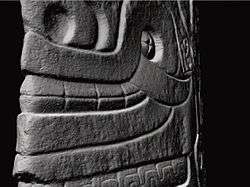Lanzón

The Lanzón is the colloquial name for the most important statue of the central deity of the ancient Chavín culture of the central highlands of Peru. The Chavín religion was the first major religious and cultural movement in the Andes mountains, flourishing between 900 and 200 BCE. The Lanzón takes its name from the Spanish word for "lance," an allusion to the shape of the sculpture.
The Lanzón is housed in the central cruciform chamber of a labyrinthine series of underground passages in the Old Temple of the ceremonial and religious center of Chavín de Huantar. Devotees would be led into the maze of pitch-black tunnels, eventually coming face to face with the sculpture's snarling mouth and upturned eyes. The worshipers' disorientation, in addition to the hallucinogenic effects of the San Pedro cactus they were given before entering, only heightened the visual and psychological impact of the sculpture.
The central image of the Lanzon functions as axis mundi, or pivot linking the heavens, earth and underworld. Position within the building also suggests centrality of image.
References
- Art of the Andes: From Chavín to Inca by Rebecca Stone-Miller (Thames and Hudson, 1995)
Piligian, C., et al. (Producers). (2012, February 2). Temple of doom: Peru [Television series episode]. In Ghost Hunters International. Sherman Oaks, CA: Pilgrim Films & Television